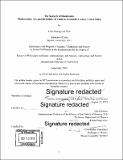| dc.contributor.advisor | David Kaiser. | en_US |
| dc.contributor.author | Kim, Clare Seungyoon. | en_US |
| dc.contributor.other | Massachusetts Institute of Technology. Program in Science, Technology and Society. | en_US |
| dc.coverage.spatial | n-us--- | en_US |
| dc.date.accessioned | 2020-03-09T18:52:01Z | |
| dc.date.available | 2020-03-09T18:52:01Z | |
| dc.date.copyright | 2019 | en_US |
| dc.date.issued | 2019 | en_US |
| dc.identifier.uri | https://hdl.handle.net/1721.1/124069 | |
| dc.description | Thesis: Ph. D. in History, Anthropology, and Science, Technology and Society (HASTS), Massachusetts Institute of Technology, Program in Science, Technology and Society, 2019 | en_US |
| dc.description | Cataloged from PDF version of thesis. | en_US |
| dc.description | Includes bibliographical references (pages 116-133). | en_US |
| dc.description.abstract | My dissertation illuminates the status of mathematical knowledge in relation to other intellectual domains and racialized social forms-particularly American Orientalism-in the twentieth-century United States. Observers and practitioners have long engaged in drawing relations between mathematics and the arts. Around the turn of the twentieth century, however, when mathematicians reconceived mathematics around notions of abstraction, formalism, and "made" theories bearing no necessary relationship to the empirical world, understandings of the relationship of mathematics to the arts changed. Historians of mathematics, mathematicians, and historians of art have since referred to these twentieth-century intellectual changes as a "modernist" transformation. They refer to mathematical modernism in terms of metaphors that reflect shared values of being autonomous, creative, and a form of self-expression. | en_US |
| dc.description.abstract | My dissertation recovers an alternative history that upends the assumption that mathematical modernism developed within pre-existing boundaries of its discipline. It tracks a series of collective efforts between mathematicians, artists, critics, and historians, to use and articulate a place for formally abstract and axiomatically derived mathematical techniques within humanistic and artistic inquiries. Drawing from archival and published sources across four main chapters, I trace four specific efforts that reflect changes and transformations in American higher education and academic institutions between the 1890s and the present. Chapter one chronicles mathematicians', historians', and art collectors' interpretations of Japanese and Chinese mathematical traditions between the 1890s and 1920s. | en_US |
| dc.description.abstract | It shows how their conclusions that the resulting "oriental mathematics" was universal but inferior to the current practices were informed by a racialized discourse, treating Japanese and Chinese math as symbols of exotic difference. Chapter two recounts and describes the production of a mathematical theory of aesthetic measure at Harvard University in the 1930s. It shows how the theory was part of a broader artistic movement to articulate a theory of pure design. Chapter three examines the valuation and nature of mathematics within the liberal arts setting at Black Mountain College in the 1940s and 50s. It recovers how rather than being essential to high art, mathematics was also critical to the resurgence of craft. The final chapter elucidates the contradictions in valuing mathematics as abstract, creative, and autonomous, by examining a copyright dispute between a mathematical origami designer and a conceptual artist in the 2000s. | en_US |
| dc.description.abstract | The resulting view of US mathematical modernism as embedded within broader intellectual domains illuminates a more nuanced view of changes in what has or has not counted as a mathematical subject. | en_US |
| dc.description.statementofresponsibility | by Clare Seungyoon Kim. | en_US |
| dc.format.extent | 133 pages | en_US |
| dc.language.iso | eng | en_US |
| dc.publisher | Massachusetts Institute of Technology | en_US |
| dc.rights | MIT theses are protected by copyright. They may be viewed, downloaded, or printed from this source but further reproduction or distribution in any format is prohibited without written permission. | en_US |
| dc.rights.uri | http://dspace.mit.edu/handle/1721.1/7582 | en_US |
| dc.subject | Program in Science, Technology and Society. | en_US |
| dc.title | The subjects of modernism : mathematics, art, and the politics of value in twentieth-century United States | en_US |
| dc.title.alternative | Mathematics, art, and the politics of value in twentieth-century United States | en_US |
| dc.type | Thesis | en_US |
| dc.description.degree | Ph. D. in History, Anthropology, and Science, Technology and Society (HASTS) | en_US |
| dc.contributor.department | Massachusetts Institute of Technology. Program in Science, Technology and Society | en_US |
| dc.identifier.oclc | 1142184735 | en_US |
| dc.description.collection | Ph.D.inHistory,Anthropology,andScience,TechnologyandSociety(HASTS) Massachusetts Institute of Technology, Program in Science, Technology and Society | en_US |
| dspace.imported | 2020-03-09T18:52:01Z | en_US |
| mit.thesis.degree | Doctoral | en_US |
| mit.thesis.department | STS | en_US |
